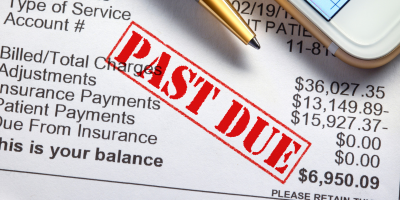Getting out of debt is not an easy task.
It’s around this time every year that the discussion increases with regards to savings plans, budget creation, and debt reduction. As someone who has tried (and failed) to get out of debt quite a few times, I’ve read articles, tried different systems, and in the end, found that there are really just seven steps necessary for success.
Tip: If you want to take control of your debt this year, grab my FREE Debt Tracker Worksheet. You can find it HERE.
Step 1: Admit you have a problem
I know it sounds like we are starting a 12-step program, but I promise you, there are only seven steps, and this one is critical. If you can’t admit you have a problem with debt, (credit cards, personal loans, having to have the newest and best car, the list goes on and on) then you will never be able to rid yourself of it.
The best way to admit and recognize the severity of your debt problem is to write it all out. Come to grips with the fact that you have it, and don’t hide it anymore. In fact, share it with your spouse (if married), kids, a best friend…you name it. Share your weakness and allow others to dream with you about the possibilities that could come if you actually reach your goal this time.
Sharing can be hard, but the nice thing is that friends and family will be even more understanding when you invite them to dinner at your house rather than suggesting a night out on the town. Once we told people we were on a payoff plan with a goal, cutting up our credit cards didn’t seem so daunting.
Step 2: Create a budget
If you missed my previous post on creating a budget, I highly recommend checking it out. Budgets are critical for debt reduction. Without one, you are almost guaranteed to fail.
Find out where you spend your money before you determine how much you can use to pay off debt. If you overspend your money, rather than planning ahead, then you will just put additional expenses on credit cards and end up even further in debt.
Step 3: Determine a timeline
Now that you have put your debt in a list on paper (grab a template HERE), determined how much you have to put towards debt each month, and totaled those debts, the next step is to figure out what your end date will be. Sure, life might happen in the middle and derail your plans, but what’s your goal date?
Our daughters are nine and eleven. Knowing that eight years from now they will both be (nearly) graduated from high school helped us determine our end date. Justin and I would like to be out of debt before they head to college, in anticipation that we might be able to do a little extra traveling or even purchase that lake house we have been dreaming about. Coincidentally, that happens to be the year we turn 40. A perfect end date.
Now, chances are we will be able to get out of debt before that, but a comfortable timeframe puts us about eight years out. And that’s good. You need to know that there is an end to the payoff plan, even if the unexpected comes up and derails you for a time. (Hopefully, your budget has already taken that unexpected expense into account…)
Keep in mind that paying off debt isn’t an easy task. It takes determination and perseverance, and a change of priorities.
What really matters to you?
Step 4 – Chart it
The most effective way I have found to see (visually) my payoff progress is to chart it. Excel workbooks are good tools for this, as well as using a debt snowball worksheet. You can find my downloadable worksheet HERE.
After you’ve plugged in all of your debts (and their interest rates), then you can see how much you are going to pay off each month to reach your goal. Write the projected end date for each debt out on a sheet of paper. Post it where you can see it.
Step 5 – Cut Spending
Remember that budget you made? Now is the time to look it over again and scale back even further. Think groceries, cable bill, insurance, and general spending. Keep in mind that I’m not talking about cutting everything. There are just some things that aren’t worth cutting.
But some things are.
At the beginning of our budget, I cut our usual amount for groceries into four weeks and categorized it that way. We began to shop weekly, which has actually helped us eat more fresh foods, and quickly found that when we grocery shop by the week, rather than thinking we have tons of money for the month, that we actually spend one-third less than I expected us to. That quickly adds up to an extra $160 per month.
Additionally, we checked around with car insurance carriers and found out that we could save $50 per month AND get a better policy. Over the course of the year that is $600 saved that can go towards debt reduction.
Check out your cable, internet, phone and any other monthly plans you have and see if there are any ways you can save.
Trust me, any little cuts you can make will make a big difference in that payoff plan.
Step 6 – Increase Income?
This one has to come with a question mark for me because I feel like everyone would love to increase their income, and yet, it’s just not always possible. I can’t say that I’ve made tons of money on survey apps or by writing a book or blog, quite the opposite. What I can say is: if you have the opportunity to increase your income, even temporarily, then that’s a smart choice to make. The sooner you are debt free, the better.
Personally, between my regular job and taking care of kids and home, I don’t have any additional time in the day to make that happen. And that’s okay with me.
Step 7 – Celebrate
You’ve got your budget figured out, a debt payoff plan in place, you’ve increased your income (if possible), and made, even minor, tweaks to your budget. Now it’s time to sit back and wait for those pay off days to come around.
It sounds silly, but celebrating is important. Remember all those people you told about your plan back in Step 1? Call them all up and celebrate when you pay something off. Don’t go all out and throw a big party that costs a lot, but have a get-together, or possibly a family night, and celebrate the sacrifice you have made to pay something off.
I told my daughters about our payoff plan when we first started. I was really specific about money-related things changing around our home. We weren’t going to go to the store mid-week because we ran out of milk, cleaning tasks would include full family commitment, and our eating out would decrease significantly. I also mentioned that, because it was going to take the sacrifice of each family member, every time we paid something off we would have a family movie night with popcorn and candy from the store.
The result: Two weeks in, the girls wanted to know if they could donate their piggy bank money to help with the payoff plan so that we could get to the movie night sooner. Talk about a whole family commitment! (And no…I didn’t take their piggy bank money. Although, it was tempting.)
Celebrate success. It will help you recognize over time that the day-to-day struggle to stick with it is actually worth it. And in the end: you’ll be debt free.
Are you paying off debt this year? Leave a message below and let us all know how it’s going so far, and how you intend to stick with it!
Tip: If you want to take control of your debt this year, grab my FREE Debt Tracker Worksheet. You can find it HERE.
SaveSave



